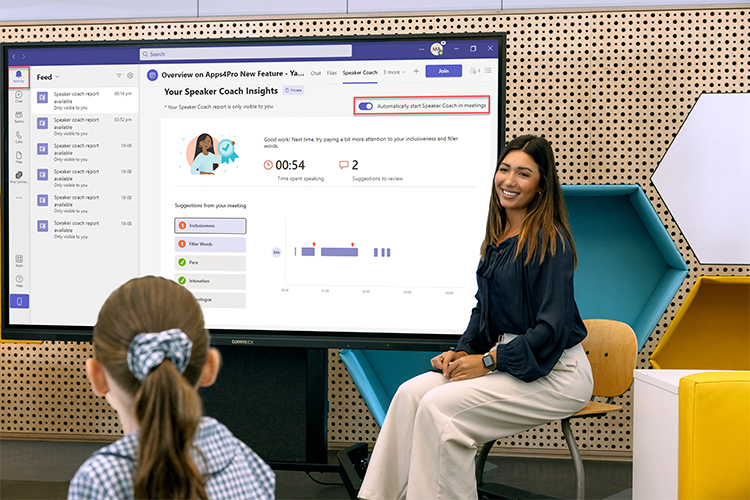AI collaboration and security in the classroom
Sarah Drysdale from Commbox discusses AI and cyber security innovations in 2024 for the education sector, and the impacts for the classroom.

In 2024, the landscape of education is transforming at an unprecedented pace, driven by the advent of artificial intelligence (AI) and an increasing emphasis on cybersecurity.
As we navigate through this year, several key trends are emerging, reshaping how educators and students interact, learn, and protect their digital environments. CommBox, at the forefront of integrating interactive touchscreens into educational settings, plays a pivotal role in facilitating these trends. Here’s a look at the major shifts in education for 2024, focusing on AI collaboration and security in the classroom from Sarah Drysdale, Head of Product at CommBox who has just returned from BETT in the UK, the world’s largest EduTech conference.
Read the latest print edition of School News HERE
Personalised Learning Experiences
Microsoft’s AI technologies such as Co-Pilot, Speech Coach and Math Coach are making it possible to tailor educational content to the individual needs of each student. Interactive touchscreens, such as those offered by CommBox, are instrumental in delivering these personalized learning experiences. They allow educators to use AI-driven applications that can adapt in real-time to the learning pace and style of students, ensuring that every learner achieves their full potential.
Enhanced Collaborative Learning
Collaboration is key in modern classrooms, and AI is making it easier than ever. In 2024, we’re seeing an increase in AI-powered tools that foster collaboration among students, both in-person and remotely. CommBox’s Interactive Classic S4 are at the heart of this trend, enabling students to work together on projects, share ideas, and solve problems collectively, irrespective of their physical location and skill level. Teaching students how to collaborate with AI is a critical skill for future success.

Cybersecurity Education
The importance of Cybersecurity in education remains a key focus for 2024. CommBox is leading the way with highly secure CommBox Classic S4 and S4+. With a certified locked down CommBox OS operating system, CommBox’s secure, interactive touchscreens ensure that these lessons are delivered in a safe, controlled environment, protecting both students and educators from potential cyber threats.
Privacy and Data Protection
As schools incorporate more AI and digital technologies into their classrooms, the importance of privacy and data protection has never been higher. In 2024, educational institutions are prioritizing secure platforms and tools that protect student data. CommBox’s commitment to security ensures that their interactive touchscreens are designed with privacy in mind, offering peace of mind to educators and parents alike.
Sustainable Technology
Sustainability is a growing concern in education, and in 2024, schools are seeking environmentally friendly technology solutions. CommBox is leading the way by providing energy-efficient interactive touchscreens that reduce the carbon footprint of educational institutions, aligning with global efforts to combat climate change.
As we embrace the opportunities and challenges of 2024, it’s clear that AI collaboration and security are at the forefront of educational innovation. With companies like CommBox leading the charge, educators and students are equipped with the tools they need to succeed in a rapidly evolving digital landscape. CommBox is available to assist educators as they strategically plan to roll out this new technology in 2024.
 Sarah Drysdale has over 25 years of experience as a teacher and tech innovator. She holds an MComm, EMBA, and Grad Dip Edu. As the Head of Product at CommBox, Sarah partners with teachers, IT managers, and school principals to create the best interactive screen for Australian schools. Because she understands teachers’ needs so well, she’s passionate about making technology that changes the classroom for the better.
Sarah Drysdale has over 25 years of experience as a teacher and tech innovator. She holds an MComm, EMBA, and Grad Dip Edu. As the Head of Product at CommBox, Sarah partners with teachers, IT managers, and school principals to create the best interactive screen for Australian schools. Because she understands teachers’ needs so well, she’s passionate about making technology that changes the classroom for the better.
Integrate AV is a Commbox Platinum Partner and has a dedicated education team who can assist you with an interactive flat panel solution for your school. Integrate AV is a supplier on contract with the NSW Department of Education Multimedia Solutions 278 State Contract, QLD Department of Education Standing Offer QEDSOA-71789 and the Tasmanian Information and Communication Hardware C150 contract.







